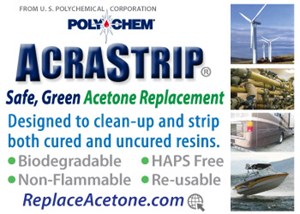CAMX 2019 exhibit preview: Sicomin Epoxy Systems
Sicomin Epoxy Systems is featuring its line of advanced epoxy systems and high-performance composite solutions, including MaxCore, its new sandwich core infusion technology, and the latest addition to the GreenPoxy range, SR Greenpoxy 28, its new bio-resin specifically formulated for high-pressure resin transfer molding (HP-RTM).
Sicomin Epoxy Systems (Marseille, France) is featuring its line of advanced epoxy systems and high-performance composite solutions, including MaxCore, its new sandwich core infusion technology, and the latest addition to the GreenPoxy range, SR Greenpoxy 28, its new bio-resin specifically formulated for high-pressure resin transfer molding (HP-RTM). In addition, Sicomin is showcasing clear, fire-retardant and foaming epoxy systems.
Sicomin says MaxCore offers a new method of dry fiber insertion into sandwich core sheets for infusion manufacturing of large composite parts for civil engineering, transportation, wind energy and marine industries. Using MaxCore, dry fibers are inserted into foam in multiple orientations and are responsible for 100% of the mechanical properties of the infused processed core. With its patented manufacturing process, Sicomin says it is able to place these reinforcement fibers at precise angles and positions within the core, resulting in 70% fiber content by weight of infused glass. Sicomin reports that MaxCore has been developed to maximize sandwich panel properties in large thickness formats. It is said to be a cost-effective alternative to classic foam cores used in composite panels. As the core material is solely a carrier for the fiber reinforcement, cores can be selected based on other parameters such as fire and smoke behaviour, water resistance, thermoformability, low resin absorption or sustainable chemistry.
SR GreenPoxy 28, the sixth product in Sicomin’s GreenPoxy range, is a fast-cycle, low-toxicity, third generation bio-based formulation aimed specifically at the HP-RTM molding processes. The new formulation reportedly has been optimized for fast production cycle times and superior mechanical performance.
Related Content
-
JEC World 2023 highlights: Recyclable resins, renewable energy solutions, award-winning automotive
CW technical editor Hannah Mason recaps some of the technology on display at JEC World, including natural, bio-based or recyclable materials solutions, innovative automotive and renewable energy components and more.
-
Collins Aerospace to lead COCOLIH2T project
Project for thermoplastic composite liquid hydrogen tanks aims for two demonstrators and TRL 4 by 2025.
-
Infinite Composites: Type V tanks for space, hydrogen, automotive and more
After a decade of proving its linerless, weight-saving composite tanks with NASA and more than 30 aerospace companies, this CryoSphere pioneer is scaling for growth in commercial space and sustainable transportation on Earth.











.jpg;maxWidth=300;quality=90)

